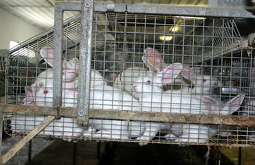Penned up in tiny spaces
Species-appropriate holding means that the animals must be given sufficient possibilities to move, dig and hide. On fur farms, five rabbits are forced to share the same mesh wire cage, with 20 x 40 cm space for each rabbit, which corresponds to about one and a half A4 format sheets of paper. In their tight and dirty cages, the rabbits can neither stand up on their hind legs nor can they hop around or dig.
Rabbits farmed in cages often suffer from painful skeletal deformations, are crippled and can hardly bear the stress of being held in masses in tight cages. This leads to abnormal behavior such as chewing on the cage walls or chasing their own tails endlessly. Often enough, the rabbits begin to cannibalize one another or to injure themselves. The mesh wire floors provoke paw injuries and because the rabbits have no possibility to use their claws or their teeth properly, they suffer from painful deformations and infections. The mesh wire cages offer no possibility for the animals to withdraw, which means permanent stress for these shy animals used to being able to flee.
Contrary to what the fur industry claims, farm rabbit fur is not an auxiliary product of meat production. Young rabbits are slaughtered for meat. In fur production, however, only somewhat older rabbits offer the thick and fluffy fur required. The meat of rabbits of this age, however, is no longer of the quality desired and is therefore usually thrown away. Moreover, most meat rabbits are also held in mesh wire cages.

